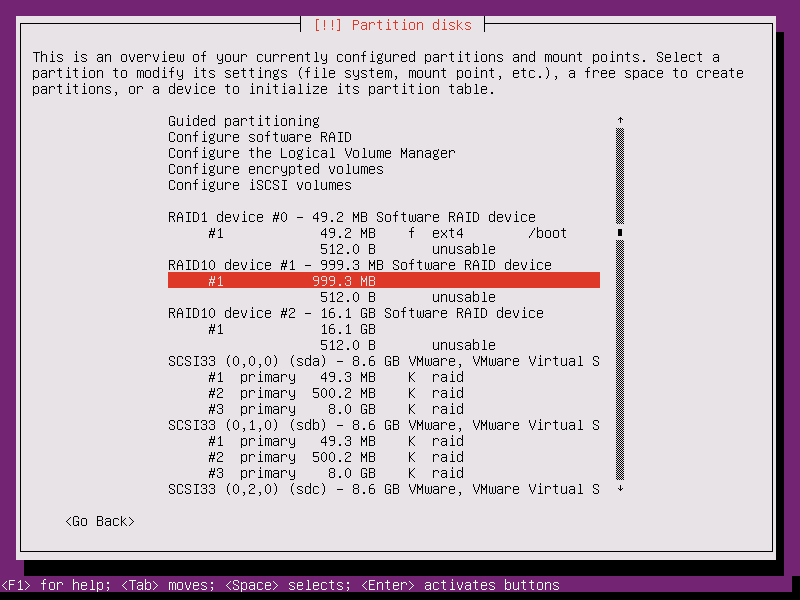Install Esxi Software Raid Ubuntu

I have a server that is not doing much but I want to keep going, it has a software RAID(1) using mdadm that I would ideally like to keep in tack and pass through ESXi. Installing Ubuntu Server with Intel Matrix RAID arrays. This article was written by Kent Baxley, Software Engineer at Canonical. Search the VMware Knowledge Base (KB. Ok, so as the title explains. My overall goal is map 4 1.5TB Drives to a Ubuntu LTS 10.04 VM, and create a software based raid 5 array and host that to the.
We recently had a brand-new RD450 donated to our school. It came with the onboard 'fake RAID' 110i preinstalled. No problem installing CentOS 7 (RedHat Enterprise Linux) and setting up hypervisor KVM on a single disk. However after installing and initializing 4 disks into a RAID 10 config, I cannot get the CentOS installer to recognize the RAID array.
Same problem with a RAID 1 too. I tried loading every available driver from Lenovo's site (for RHEL 6.7, 7.0 and 7.1) during install, per Lenovo's instructions, and tried CentOS 6.7, but no go. This is all a bit annoying because Lenovo's support site indicates that RHEL/CentOS supports the 110i with Lenovo's drivers. (And mind you, this is all before KVM even gets installed-I'm just trying to get the O/S installer to see the RAID. For all I know KVM will have a problem with the 110i.) Options from here? (1) buy a hardware RAID card (2) turn off RAID support in the BIOS and let Linux set up the RAID (3) figure out how to get the @#$% drivers loaded by the Linux installer I'd really like to do (2), but had no luck there either.
In the BIOS there is an option to set SATA mode from 'RAID' to 'AHCI', but after making that change, the installer still would not see the disks. Some posts have suggested looking for a 'Disable SCU' option but I don't see that anywhere. Any suggestions? Thank you for the reply.
Software Raid Download
I have disabled onboard RAID (setting SATA mode in BIOS to 'AHCI') and am trying to get RHEL 7 to recognize the disks, without success. It seems the RedHat anaconda installer still thinks the disks are marked for inclusion in a RAID array that it cannot make sense of. Either it is reading RAID metadata on the disks, or the controller is somehow confusing the installer. (Note: this is all still well before the point of installation of a hypervisor environment -but thanks for pointing out that even if I could get the 110i RAID array to be recognized by RHEL, virtualization would not work.
) I do not have the budget to upgrade to a hardware RAID solution, I just want the SATA controller to present the disks as usable for the Linux installation. Thank you, yes, as I suggested in my prior message there was RAID metadata on the disks that the anaconda installer was seeing. I did not realize that I needed to explicitly destroy the RAID in order to remove the metadata; I incorrectly assumed that with the controller not running in RAID mode, any metadata would be ignored. Clearly this was not the case. Rather than using the Lenovo / BIOS-based utilities to destroy the RAID, I booted with the installer disk and used the Linux command-line tool dmraid to erase the metadata.
Install Esxi Usb
(Some blog posts online suggested that you write zeros to the first few blocks of each disk too, just in case, so I did this as well, using dd.) I now have a nice LVM (Linux-based software RAID) setup going on the RD450. Thanks again for the responses.
Attention, Internet Explorer User Announcement: VMware Communities has discontinued support for Internet Explorer 7 and below. In order to provide the best platform for continued innovation, VMware Communities no longer supports Internet Explorer 7. VMware Communities will not function with this version of Internet Explorer.
Esxi Intel Raid
Please consider upgrading to Internet Explorer 8, 9, or 10, or trying another browser such as Firefox, Safari, or Google Chrome. (Please remember to honor your company's IT policies before installing new software!).